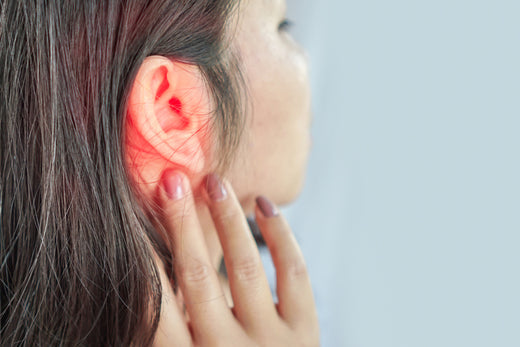Recognizing an ear infection early is important to avoid complications and relieve discomfort. Ear infections happen when bacteria or viruses infect the ear, causing pain and other symptoms. They can affect the outer, middle, or inner ear, and they are especially common in children. Knowing the symptoms of an ear infection can help you determine when it’s time to seek treatment.
What is an Ear Infection?
An ear infection is when bacteria or viruses cause swelling and fluid buildup in different parts of the ear. There are three main types: otitis externa (outer ear infection), otitis media (middle ear infection), and labyrinthitis (inner ear infection). These infections often cause discomfort and hearing problems. In many cases, ear infections clear on their own, but some may need medical attention, especially if symptoms persist.
Types of Ear Infections
There are three types of ear infections. Otitis externa affects the outer ear and often causes swelling around the ear. Otitis media happens behind the eardrum, causing pain and ear fluid buildup. Labyrinthitis affects the inner ear, leading to dizziness and balance issues. Understanding which type of infection you have can help determine the right treatment.
Common Symptoms of Ear Infections
The symptoms of an ear infection vary depending on which part of the ear is affected. Common signs include ear pain, difficulty hearing, and fluid drainage from the affected ear. You might also feel pressure or fullness in the ear. Other symptoms include fever, trouble sleeping, and irritability, especially in children. Severe pain or a lasting infection means it’s time to see a doctor.
Signs of Otitis Media (Middle Ear Infection)
Otitis media, or middle ear infection, is the most common type, especially in children. The symptoms of an ear infection in the middle ear include ear pain, fever, and fluid buildup behind the eardrum. Hearing loss and trouble sleeping are also common. The infection happens when the eustachian tube, which connects the middle ear to the throat, gets blocked by mucus or swollen tissues from a cold.
Risk Factors for Otitis Media
Several factors increase a child's risk for otitis media. Children are more prone to this infection due to their smaller and more horizontal eustachian tubes. Other risk factors include frequent colds, exposure to tobacco smoke, and attending daycare, where germs spread more easily. Reducing these risks can help prevent ear infections in young children.
Signs of Otitis Externa (Outer Ear Infection)
Otitis externa, also known as swimmer's ear, affects the outer ear. It often occurs when water gets trapped in the ear, creating a moist environment where bacteria can grow. Symptoms include ear pain, swelling around the ear, and discharge. The pain may get worse when you pull on the affected ear or lie down. Itchiness and a feeling of fullness are also common.
Risk Factors for Otitis Externa
Swimmers are at higher risk for otitis externa because water can easily enter the outer ear canal. Other risk factors include inserting objects like cotton swabs into the ear and skin conditions such as eczema. Preventing this type of infection includes keeping your ears dry, avoiding swimming in polluted water, and not using objects that may irritate the ear canal.
Signs of Labyrinthitis and Vestibular Neuritis (Inner Ear Infection)
Labyrinthitis and vestibular neuritis are infections that affect the inner ear. These conditions usually occur after a viral infection, like the flu. Symptoms include vertigo (a spinning sensation), dizziness, and trouble balancing. Other symptoms of an ear infection in the inner ear include hearing loss and ringing in the ears (tinnitus). If you experience these signs, it’s important to see a doctor.
When to Seek Medical Attention for Inner Ear Infections
Inner ear infections can disrupt your balance and hearing. If you experience severe vertigo, hearing loss, or nausea, you should seek medical help. These infections can sometimes lead to long-term complications if left untreated. A doctor can prescribe antibiotics if needed or recommend treatments to relieve symptoms like dizziness.
How to Identify an Ear Infection in Babies and Toddlers
Ear infections are very common in young children due to their smaller eustachian tubes. Symptoms of an ear infection in babies include ear pulling, trouble sleeping, irritability, and refusal to eat. They may also develop a fever or show signs of ear pain. If your child seems fussier than usual or has more ear infections, it's a good idea to check with a doctor.
What to Do if Your Child Has an Ear Infection
If you think your child has an ear infection, watch for signs like ear tugging or crying more than usual. You can give over-the-counter medicine to relieve pain, but it’s important to consult a doctor if the infection lasts more than a few days or if the symptoms get worse. Some children may need ear tubes to prevent chronic ear infections.
Complications of Untreated Ear Infections
Most ear infections are not serious, but if left untreated, they can cause complications. One of the most common is a ruptured eardrum, which may lead to hearing loss. Chronic otitis media can also develop, causing persistent ear infections and lasting ear fluid. In rare cases, untreated ear infections can spread to nearby areas and require neck surgery.
When to Seek Urgent Care for an Ear Infection
Seek medical attention if you or your child experience severe pain, drainage from the ear, or a high fever. These could be signs of a more serious infection. If the symptoms don't improve within a few days, it may be necessary to prescribe antibiotics or consider other treatments to avoid complications.
Diagnosing an Ear Infection
Doctors can usually diagnose an ear infection by reviewing your medical history and examining the affected ear with an otoscope. This tool helps the doctor see behind the eardrum and detect any signs of infection. In some cases, hearing tests or fluid samples may be needed to confirm the diagnosis and decide if antibiotics are required.
Treatment Options for Ear Infections
Most ear infections clear up on their own, but treatment may be needed if symptoms are severe or don’t improve after a few days. Pain relievers like ibuprofen can help relieve pain. In some cases, doctors may prescribe antibiotics for bacterial infections. For children with chronic ear infections, ear tubes may be recommended to help drain fluid and reduce the number of future infections.
Home Remedies and When They’re Effective
Home remedies like warm compresses can relieve pain from ear infections. Over-the-counter pain medications also help. However, these remedies should be used with caution and only for mild symptoms. If the infection doesn’t improve within a few days or gets worse, see a doctor to avoid complications.
Can Ear Infections Clear Up Without Antibiotics?
Many ear infections clear on their own without the need for antibiotics. This is especially true for mild cases of otitis media and otitis externa. However, if symptoms worsen or last more than two to three days, medical help may be needed. Doctors try to avoid over-prescribing antibiotics to prevent resistance, but they may be necessary in more severe cases.
Preventing Ear Infections
To prevent ear infections, it’s important to maintain good ear hygiene and avoid factors that can lead to infections. For children, keeping up with vaccinations, avoiding pacifiers after six months, and reducing exposure to tobacco smoke can lower their risk. Swimmers can prevent ear infections by wearing earplugs and drying their ears after swimming.
Conclusion
Ear infections can cause a range of uncomfortable symptoms, from ear pain to difficulty hearing. Recognizing the signs early and seeking the right treatment is important, especially for young children who are more prone to these infections. While many ear infections clear up on their own, others may need medical care or antibiotics. In some cases, earwax buildup can contribute to discomfort and may be mistaken for an infection. Using an ear irrigator can help safely remove excess wax and reduce the risk of infection. By understanding the symptoms, risk factors, and treatments, you can take steps to manage ear infections and prevent future ones. If you're ever unsure, consult a healthcare professional for guidance on the best course of action.
Frequently Asked Questions
Can you get rid of an ear infection on your own?
Many ear infections, especially mild cases of acute otitis media, can clear up on their own without the need for antibiotics. Over-the-counter pain relievers, rest, and home remedies like warm compresses can help manage discomfort. However, if the infection is severe, lasts more than a few days, or causes fluid buildup behind the eardrum, it’s important to consult a doctor for proper treatment.
What can be mistaken for an ear infection?
Sometimes, other conditions can mimic the symptoms of an ear infection. For example, eustachian tube dysfunction, which causes pressure and discomfort in the ear, can feel similar. Sinus infections, temporomandibular joint (TMJ) disorders, and even dental problems can also cause an ear feeling of discomfort. It’s important to see a doctor to determine if the issue is truly an ear infection or something else.
What is a silent ear infection?
A silent ear infection, also known as "otitis media with effusion," occurs when fluid builds up behind the eardrum without causing obvious symptoms like severe pain. This type of infection is more common in children and can lead to hearing problems if left untreated. While there may not be significant discomfort, a silent ear infection may still require medical attention to avoid complications.
What feels like an ear infection but isn’t?
Several conditions can cause symptoms similar to an ear infection but aren’t. TMJ disorders, where the jaw joint becomes inflamed, can cause ear pain. Sinus infections, throat infections, and even impacted earwax can also create a sensation of fullness or pain in the ear. In these cases, although the ear feeling is similar, the underlying cause isn’t related to an actual infection.
When should an adult see a doctor about an ear infection?
An adult should see a doctor if they experience severe pain in the ear, hearing loss, or symptoms lasting more than two to three days. If the infection leads to fluid draining behind the eardrum, a high fever, or dizziness, medical attention is necessary. Otitis media or more serious ear infections may require antibiotics or further treatment, so it’s important not to ignore persistent symptoms.








Share:
Related Blogs
Why Does My Ear Feel Blocked?
Understanding the Connection Between Diabetes and Hearing Loss